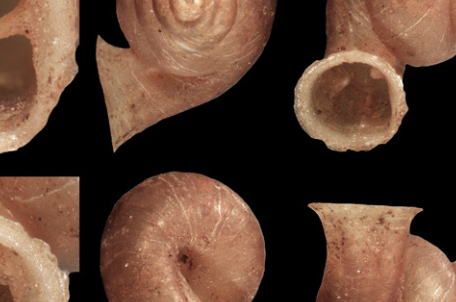1980년, 뉴욕시에 있는 미국자연사박물관에서는 콜럼비아대학으로부터 광물수장품(收藏品)하나를 사들였다. 그 광물수장품에는 호박(琥珀)몇조각이 포함되어 있었는데, 두어달전 관리자의 한 사람인 '데이비드 그리말'디, 씨가 이 호박조각을 면밀히 조사하다가 8천만년 전의 벌 한마리를 발견하였다.
곤충들을 성가시게 하는 해로운 것이라고 생각하는 사람들에게는 대수롭지 않겠지만 사실은 곤충들이야말로 지구상의 생물가운데 가장 성공적인 유(類)이다. 만일 어떤 먼 행성출신의 한 외계인이 지구를 조사하고 있었다면, 그는 자신의 상관에게 지구는 다른 형태의 생물체들은 부수적으로 산재하고 있을뿐인 곤충들의 세계였다고 담담하게 보고했을것이다.
거의 백만종의 상이한 곤충종들이 알려져 있음을 생각해보라. 이것은 다른 모든 생물의 총종수를 합한 것보다도 훨씬 많은 수이다. 사실 지구상에 존재하는 생물종의 6가지 가운데 약 5가지는 곤충들이다.
더구나 이것은 알려져 있는 생물체만을 포함시킨 것뿐이다. 아직 발견되지도 않은 그리고 이름붙여지고 기술(記述)되지 못한 수백만의 종들이 존재하며-특히 열대림속에-이들 중 거의 모두가 한개 또는 여러 종류의 곤충들일 것으로 확실시된다. 대략 2백만에서 5백만종에 이르는 곤충들이 실제로 존재하고 있을지 모르며 또 모든 종의 97%까지가 곤충일 가능성이 있다.
곤충들은 왜 그토록 성공적일까? 그들은 작다. 그리고 그들은 헤아릴 수 없을 정도로 많은 알을 낳는 다산(多産)성이다. 습지 1에이커에 4백만마리의 곤충들이 있을 수 있는 것이다.
이는 곤충들을 멸종시키기가 어렵다는 것을 의미한다. 100에서 99를 없애더라도, 겨우 살아남은 것들은 금방 원래의 수를 회복할만한 알을 낳을 것이다. 사실, 인류가 맘모스와 마스토돈을 포함한 여러 종의 생물체들을 쉽게 멸종으로 몰아갔고, 또 오늘날에도 다른 많은 생물체들을 위협하고 있지만, 아무리 애를 쓴다 해도 단 하나의 곤충종도 전멸시키지 못했다는 것이 드러날것이다. 예를 들어, 모든 사람들이 적대시함에도 불구하고 바퀴벌레와 모기는 번성하고 있는 것이다.
숫자상의 커다란 변동은 진화가 곤충들 사이에서 엄청난 속도로 진행되고, 그리하여 새로운 특성을 지닌 새로운 종이 우리 주위의 통상적인 동물들에 적용되는 것보다 훨씬 빨리 형성되어 가고 있음을 의미한다. 이따금 우리는 살충제로 곤충들을 대량살상하며 수십억 마리의 곤충을 죽이고 있다. 그러나 상대적으로 적은 수의 곤충들은 어떤 특정 살충제에 자연적으로 저항력을 갖게 된다. 그들은 살아남아 수백만의 후손들을 거느리는데, 이들 모두는 저항력이 있는 것들이다. 수년만에 그 살충제는 효력을 상실하며 새로운 살충제가 만들어지지 않으면 안되게 된다.
고생물학자들은 곤충의 진화적 발전에 대한 상세한 것들을 굉장히 알고 싶어 하겠지만, 그것은 적고 또 화석도 거의 남아있지 않다. 가장 오래된 곤충들의 흔적은 매우 원시적인 '튀는 벌레'(彈尾類)의 것들로서, 이 곤충은 날개가 없고, 위협받을 때 도망가려는 시도로서 튀는 것밖에는 할 수가 없다(이러한 탄미류들은 오늘날에도 아직 존재하고 있다). 탄미류는 최소한 3억7천만년 전에 살았다.
약 2억8천만년 전, 거대한 잠자리들은 날개폭이 27.5인치에 달할정도로 진화해왔는데, 이것들은 이제까지 살았던 곤충들 중 가장 큰 것이었다.
그러나 곤충들의 진화기록은 빈 틈으로 가득차있다. 그렇지만 우리에게는 하나의 행운이 있다. 종종 곤충들은 옛날 상록수(지금은 멸종된)에서 스며나온 끈적한 나무진에 걸려들었다. 이 나무진이 지금 우리가 호박이라고 부르는 재질로 화석화되었고, 이 호박은 곤충의 몸을 수백만년 동안 묻어 온것이다. 이렇게 발견된 최고(最古)의 곤충은 1억 2천만년이나 되었다.
아주 최근에 호박에서 발견된 벌(원래 뉴저지주 벌링턴군에서 나온)은 그렇게 오래된 것은 아니지만 이제껏 발견된 어떤 벌의 유물보다도 배나 오래된것이다. 그리고 8천만년이나 지났음에도 선명하고 자세히 볼수있다.
놀라운 것은 그것이 8천만년 전의 것임에도 불구하고, 오늘을 살고 있는 것과 크게 다르지 않은 진화된 벌이라는 점이다. 그것은 아직도 적도지역에 살고 있는 벌과(科)에 속한, 침없는 꿀벌이다. 추측컨대, 8천만년 전의 뉴저지주는 현재보다 훨씬 따뜻했다.
8천만년 전에 그렇게 발전된 단계까지 진화해 왔으므로, 벌은 그보다 오래전에 형성된 것이 틀림없다. 아마 그로부터 다시 8천만년 전쯤. 이는 식물과 관련해서도 중요하다. 개화(開花)식물은 벌(그와 유사한 곤충도 포함해)과 함께 진화해 온 것으로 생각되는데, 왜냐하면 이 둘은 서로 연관되어 있기 때문이다. 벌은 본래 화밀(花蜜)을 먹고 살며 반면 꽃은 벌이 이꽃에서 저꽃으로 꽃가루를 옮겨주기 때문에 번식한다. 개화식물은 약 1억 3천2백만년 전에 생겨난 것으로 생각되지만, 만일 벌이 그보다 더 오래되었다면 꽃도 마찬가지인 것이다.
고생물학자들은 조사를 계속하고 있다. 호박에서 발견되는 곤충 하나하나가 귀중하다.
The American Museum of Natural History in New York bought a mineral collection from Columbia University in 1980. The mineral collection included pieces of amber, and a couple of months ago, a museum curator, David Grimaldi, looking over the bits of amber, found himself staring at a bee that was 80 million years old.
It may not seem like much to those of us who dismiss insects as annoying pests, but the fact is, insects are the most successful forms of life on Earth. An alien from a distant planet who was examining Earth dispassionately might well report back to his superiors that Earth was an insect world with an unimportant scattering of other types of life as well.
Consider that almost a million different species of insects are known. This is a far greater number than the total of all other species of life combined. In fact, about five out of every six species of life on Earth are insects.
What's more, this only includes the life forms that are known. There are many millions of species that have not yet been discovered, named and described - especially in the tropical forests-and of these it is confidently estimated that almost all are insects of one sort or another. There may be anywhere from 2 million to 5 million species of insects actually in existence and it is possible that up to 97 percent of all species are insects.
Why are insects so successful? They are small and they are fecund, laying uncounted numbers of eggs. There may be as many as 4 million individual insects in one moist acre of land.
This means that insects are difficult to wipe out. Kill 99 out of 100 and those who manage to survive will lay enough eggs to restore the population in no time. In fact, although human beings have easily driven to extinction various large forms of life, including mammoths and mastodons, and are endangering many others today, it would appear that despite our best efforts, we have never managed to wipe out a single insect species. Roaches and mosquitoes flourish, for instance, though every person's hand is against them.
The vast turnover in numbers means that evolution proceeds at an enormous rate among insects, so that new species with new characteristics are being formed much more quickly than is true for the ordinary animals about us. Every once in a while we slaughter insects with insecticides and kill billions of them. A relatively few, however, just happen to be naturally resistant to a particular insecticide. They survive and rapidly have millions of descendants, all resistant. In the space of a few years, the insecticide loses its value and a new one has to be found.
Paleontologists would dearly love to have the details of the evolutionary development of insects, but they are small and leave few fossils. The oldest traces are insects are those of very primitive "springtails," insects that have no wings and can do no more than spring in an attempt to get away when frightened. (Such springtails still exist today.) Springtails lived at least 370 million years ago.
About 280 million years ago, giant dragonflies had evolved with a wingspread of up to 27 1/2 inches, the largest insects that ever lived.
But the evolutionary record of insects is full of gaps. And yet we have one lucky break. Occasionally insects were trapped in the sticky resin exuded by ancient(now-extinct) evergreen trees. The resin fossilized into the material we now call amber and the amber kept the insect bodies entombed for millions of years. The oldest insects thus found are 120 million years old.
The bee that was found very recently in amber (a piece that originated in Burlington County, N.J.) isn't quite that old, but it is twice as old as any other bee relic ever located, and yet, even after 80 million years, it can be seen clearly and in detail.
The surprise is that even though it is 80 million years old, it is an advanced bee, not very different from those alive today. It is a stingless honeybee belonging to a family of bees that still exists in tropical regions. Presumably, New Jersey, 80 million years ago, was considerably warmer than it is now.
To have evolved to that advanced stage of development 80 million years ago, bees must have formed long before that - perhaps another 80 million years before. This is of importance in connection with plants. It is thought that flowering plants evolved along with bees(and similar insects), for the two are connected. Bees live essentially on the nectar of flowers, while flowers reproduce because bees carry pollen from one flower to the next.
Flowering plants are thought to have originated about 135 million years ago, but if bees are older than that, then so are flowers.
Paleontologists continue to look. Every insect found in amber is precious.
이 기사의 내용이 궁금하신가요?
기사 전문을 보시려면500(500원)이 필요합니다.
1988년 03월 과학동아 정보
🎓️ 진로 추천
- 지구과학
- 생명과학·생명공학
- 역사·고고학

















